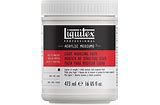Artist’s Complete Guide to Texture Pastes: Introduction
C$0
Blog Post
In stock
1
Save this product for later
Customer reviews
Reviews only from verified customers
No reviews yet. You can buy this product and be the first to leave a review.
Artist’s Complete Guide to Texture Pastes: Introduction
Product Details
Things I Wish I Knew Before Starting Texture Art: The Complete Guide to Modeling Paste
If you’re new to texture art or mixed media, one of the most important materials you’ll come across is modeling paste. But figuring out which type to use, how to apply it, or even what it actually does isn’t always easy — especially when you're just starting out. I know, because I’ve been there.
That’s why I created this guide — to give you real, practical answers to the questions I had when I started. It's called “Things I Wish I Knew Before Starting Texture Art”, and it’s designed to help you learn faster, skip the trial-and-error, and feel confident working with modeling paste.
This guide is divided into several focused parts, and I recommend reading the entire series — either here on my blog or across my social media — so you don’t miss a step. Each part builds on the last and walks you through everything you need to know to use modeling paste like a pro.
Part 1: Types of Modeling Paste + Brand Guide
- Overview of different modeling paste types: light, heavy, crackle, coarse, flexible, and more
- Uses and effects of each type
- Brand recommendations based on availability in different countries
- Budget-friendly vs. professional-grade options
Part 2: How to Choose the Right Modeling Paste for Your Project
- Factors to consider: art style, surface type, desired texture and finish
- Matching paste types to specific project needs
- How to avoid wasting money on unsuitable products
Part 3: How to Use Modeling Paste (Tools + Techniques)
- Essential tools for applying modeling paste
- Best surfaces to work on
- Step-by-step beginner-friendly application methods
- Tips to avoid common mistakes and achieve desired textures
Part 4: Mixing and Coloring Modeling Paste
- How to tint modeling paste using acrylic paints, inks, and pigments
- Controlling opacity, texture, and finish with color additives
- Creative effects you can achieve by mixing colors directly into the paste
Part 5: Advanced Techniques: Sculpting, Stenciling, and 3D Effects
- Techniques for sculpting and carving modeling paste
- Using stencils and molds to add patterns and texture
- Layering and combining modeling paste with other mixed media elements
Part 6: Troubleshooting + Pro Tips I Wish I Knew Earlier
- Common problems: cracking, peeling, slow drying
- How to fix or prevent these issues
- Tips for extending the life of your textured artwork
- Lessons learned from my personal experience
If you’re serious about leveling up your texture art, this guide will save you a lot of time, confusion, and wasted supplies.
Make sure to follow along and read the full series here on the blog or across my social media. If you have a specific question, feel free to reach out — I’m happy to help and might even feature it in a future post.
Let’s demystify modeling paste together — and make texture art a whole lot more fun (and less frustrating).
Display prices in:CAD

